Japanese Freight Cars
Japanese freight cars are identified by identifiers in Katakana symbols (typically two-character, but one-character and three-character are also used). Each character represents a phoneme, which has a two-letter Roman-alphabet (e.g., ワ is pronounced “wa”, and ワム is pronounced “wa-mu”).These symbols are typically painted on the side of the prototype car.
The first symbol is often suspiciously close to the English word describing their function and denotes the class of cars, while the second is used similarly to passenger cars to denote loading weight (according to a couple of other web sites, see references). A third character is suffixed on some hybrid designs (see the Caboose section below). A series number is typically appended (e.g., TAKI-10000) to identify the specific kind of car in the larger class, and cars are usually numbered within that series. Sometimes sub-series are given distinct numbers by prefixing the class number, but are still considered members of that class. For example, the WAMU 280000 series cars are numbered 280xxx, but considered WAMU 80000 cars).
Many of these classes filled niche roles, and are apparently no longer in use (e.g., refrigerator cars seem to have been entirely replaced by refrigerated containers, to allow transshipment onto trucks). But tank cars, box cars, gondola cars and hopper cars are still fairly common, as are flat cars designed to carry containers. The list below omits cars that were obsolete prior to the 1980s (where those could be identified), but includes many that apparently did not survive the JNR to JR breakup in 1987, particularly where those provide insight into features of the design of later cars.
Speed is a factor in Japanese freight car design, for two reasons. First, freight trains are secondary to passenger trains, and in the post-1987 era mostly operate on tracks owned and maintained by passenger rail companies (a reversal of the North American approach). To minimize schedule disruption it is preferable for freight trains to run at the same speed as the passenger trains they mix in with. Second, one place where trains have been most successful in competing with trucks has been on time-sensitive cargo, such as express freight (typically in containers). High-speed freight trains have been a recurring theme in Japanese freight railroading.
Because of the limited size and weight allowances of Japanese railways (as compared with modern North American or European railroads) freight cars tend to be small, and cars with two fixed axles (rather than a pair of pivoting two-axle trucks) are still in use, even as many have evolved to use longer car designs with trucks that support 100 kph or faster use. This is one reason Japanese freight has had problems competing with road vehicles: it is has less of an “economy of scale” than would be found with larger, heavier and, in some cases, faster cars. Older cars also used friction bearings, and some may still be in use as conversion of WAMU 80000 cars (which use fixed axles) to roller-bearings in the mid 1990’s was considered a significant development.
In the following descriptions, the first specific reference (e.g., “WAMU 80000”) is typically a link to the Japanese wikipedia page, as that’s usually the only information available. While some of that has been summarized in the brief text here, consult the referenced pages (using translation tools such as Google Translate) for much more information. Subsequent links will typically be to Wikimedia images of the specific or representative cars. However in some cases this exact structure isn’t followed due to a lack (or excess) of pages to link to.
A note on pronunciation and spelling:
The Japanese Katakana symbols are a phonetic alphabet, meaning each symbol stands for a single sound (there are modifiers that make a new symbol for a different but related sound). There are several conventions for converting these into the Roman alphabet that attempt to convey the sound as well, with varying degrees of accuracy. For this reason, English-language writings may use different strings of letters to represent the same Japanese set of symbols. The ones that matter for rail car names are: “シ” (SI or SHI), and “チ” (TI or CHI). In addition, “ワ” (WA) is sometimes written “WHA”, and the terminal “U” of “ム” (MU) is often omitted to correspond to the “Tokyo dialect” pronunciation (e.g., Google Translate writes WAMU as WHAM). Finally, the phonemes beginning with “R” are really midway between an “R” and an “L” sound, and are written either way, although “R” seems more common. Thus “ラ” (RA) may be written LA in some materials.
The omission of a weight suffix denotes a car with a loading weight less than 14 (metric) tons. Other weights:
MU (ム): 14 - 16 tons
RA (ラ): 17 - 19 tons
SA (サ): 20 - 24 tons
KI (キ): 25 tons or more (most modern cars are “KI”)
In at least one case (O-TOKI) the symbol “オ” (read “O”) is prefixed to the car marking to distinguish the larger (or perhaps in this case more specialized) of two models.
In addition, some other suffixes are used for reasons explained in the text below.
Boxcars
A boxcar is a box on wheels, with one or more doors on each side, used for transportation of cargo in bales, boxes, drums, crates or on pallets. Some specialized ones are equipped to carry rolls of newsprint, and boxcars have also been used to transport vehicles. In Japan, one variant has the top removed to carry woodchips, essentially making it a high-sided gondola car, but still classified as a WAMU. (Japanese).
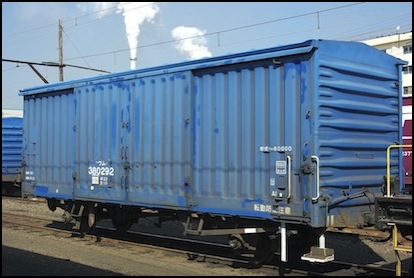
WaMu 80000 Boxcar, 380000 series (2006)
Photographer: Rs1421
Types
WA (ワ), WAMU (ワム), WARA (ワラ), WASA (ワサ), WAKI (ワキ)
WA 100
WAMUFU 1000, WAMU 80000
WARA 1
WAKI 1000, WAKI 5000, WAKI 10000, WAKIFU 10000, WAKI 50000
See also the Baggage Car section for the WAKI 8000 and WASAFU 8000.
The ordinary boxcar is still prevalent in Japan, used for carrying bulk paper products, woodchips, and other commodities that don’t fit into domestic containers or other, more specialized, cars. Some are also used as “rescue” cars, stationed at strategic locations and equipped with equipment and supplies for wreck clean-up and other emergency use. Surprisingly, most if not all of the remaining boxcars are the smaller WAMU two-axle versions, such as the WAMU 80000 (which includes models with 180000, 280000, 380000, 480000 and 580000 numbering, all of which are classed as WAMU 80000). Although new WAMU don’t appear to have been built after 1981, existing models have been upgraded (e.g. with roller-bearings) in subsequent years. The WAKI 5000, although designed for express use (up to 85 kph) and equipped with trucks and a longer frame, are no longer in use for freight. The earlier 1000-series vehicles were gone by the JNR breakup in 1987.
The WAMU 80000 was developed in 1960 to allow forklift-loading of palletized cargo, as a counter to the increasing use of containers. The original series was limited to 65 kph. Later, the 180000 series raised the speed to 75 kph to match the standard freight speed after 1968, and earlier models were upgraded or scrapped. After 1975, the 280000 series extended the wheelbase for stability and replaced the doors with lightweight aluminum. It would appear that surviving brown cars are 280000 series or variants. In 1992 improvements to the wheel bearings were made, creating the 380000 series, which are painted blue. After the breakup of JNR, general-freight yards were closed, and the cars mostly survived to carry paper products. Some were converted to the 480000 series in 1998 to carry woodchips, but use of these ended in 2008. Some other specialized variants were classified in the 580000 series, and some of these may remain in use. The last “blue car” mainline freight unit train ran 17 March 2012 (see this thread on JNS Forum for details and video).
The WA 100 was a specialty design, not actually a boxcar, produced in 1992. It was really a set of disconnected bogies (type FT1A), to which complete road semi-trailers could be attached (similar to the RoadRailer design used in the U.S.). Apparently only three trucks were produced, and they were only used until 1996 when service was discontinued (one end of the service was at Tokyo). They were apparently stored at Kawasaki and brought out of retirement in 2009 for another trial.
A set of twenty WAKI 1000 were produced in 1991/1992 to transport tank trucks (I think it really means tank containers that could be loaded on trucks, but the translation is unclear) due to a shortage of drivers. These were designed to operate at up to 110 kph, but were operated at 95 kph. However changing economic conditions led to them becoming non-competitive and the service was discontinued and the cars scrapped in 1996.
The WAKI 5000 is a variant of the WAMU 8000, longer and using trucks, with a top speed of 85 kph, originally intended for carrying large pallets. These saw their original role taken over by containers, particularly the new 30-foot domestic containers introduced in 1990. Use by JR Freight ended in 2002, although JR West and JR Hokkaido apparently have one each used as “relief” vehicles.
The WAKI 10000 was introduced in 1965, with a top speed of 100 kph, for high-speed express freight use. A refrigerated variant, the RESA 10000 (see below) was also made. Some apparently survived until fairly recently (possibly as baggage or express freight cars on passenger trains, the machine-translated text is unclear). Some of these (possibly converted to WAKI 50000) were used with passenger trains to carry cars (through the Seikan tunnel, among other uses), but the last “train car” apparently ended in 1998. The final car was scrapped in 2007.
As in North America, many surplus boxcars were sold for use as sheds and small warehouses.
Vehicle Transporter
SIMU (シム), specialized car for carrying other vehicles. Although this is sometimes used to designate an auto transporter (e.g., the SIMU 3000), per Japanese Wikipedia the SIMU designation seems to be a broader one for rail cars that can carry other vehicles (including flatcars used to carry rail cars).
SIMU 1000, SIMU 3000
SIMU 100 (4 cars, 101-104) was built 1964-1967 for the Tokyu Car Company to transport railway vehicles, particularly Shinkansen. In 1991, two were rebuilt into the SIMU 1000 series (1001, 1002) in 1991. Three more of the 100 series were produced in 1969 and scrapped in 1973. A final six were produced in 1976, and remain stored at Toyokawa station as of 2006.
However, the SIMU 1000 designation seems to have been reused, as a SIMU 1000 series (apparently a 9.5m, 12 ton capacity, flatcar) was built from 1963 to 1965 to transport Toyota automobiles, but was scrapped in 1968 due to the difficulty of loading and unloading them by crane. The newer form was stored at Kawasaki Freight Station as of 2006.
A new pair of SIMU 100 (116, 117) were produced in 1987, but these did not use the same design as the earlier models, but were instead converted TIKI 7000 flat cars.
The Japanese Wikipedia page cited above notes that from 1920 to 1987 the SIMU was essentially produced using the same steel-frame, wooden-deck design over a period of 67 years, making it the longest-produced freight car design in Japan.
The SIMU 3000 apparently was equipped with an elevator and turntable, to permit loading of cars to two levels. It’s unclear if this was an enclosed vehicle, or merely a flatcar with a frame above it on which cars could be stored on a second tier. The elevator made this a complex car, and the last was scrapped in 1970 and replaced in function by the KUMU 5000.
Livestock Car
A livestock car, also known as a “cattle car”, is a ventilated boxcar used for transporting larger livestock from farm to slaughterhouse. (Japanese)
KA (カ), KAMU (カム)
KA 2000, KA 3000, KAMU 1
Used primarily for cattle and goats, the livestock car was obsolete by 1977. A separate kind of car was used for poultry, but wikipedia lacks even a Japanese-language description of these. Presumably they are long obsolete.
Refrigerator car
A refrigerator car is a closed box, either well-insulated and not actively cooled, or cooled by either ice or mechanical refrigeration units. (Japanese)
Note: the Japanese RESA is often translated as LESA by Google, but REMU is not.
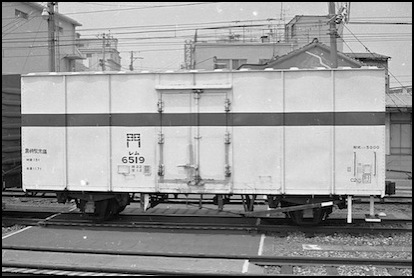
ReMu (c. 1985)
Photographer: 永尾信幸
Types
RESA (レ サ), REMU (レム)
RESA 5000, RESA 10000, REMUFU 10000
The RESA 10000 and REMUFU 10000 cars were introduced in 1966, raising the top speed of refrigerated trains to 100 kph, primarily for refrigerated fish. The conductors compartment was identical to those used on the KOKIFU 10000, and was painted blue.
The RESA 5000 was introduced slightly later (1968) for lower-speed trains, to replace older equipment. Because there were no cabooses rated for 100 kph use, the REMUFU incorporated the conductors room on the end, similarly to the KOKIFU 10000. But trucks and refrigerated containers eventually took over the traffic, and the cars were retired by 1986.
Ventilated Boxcar
(Japanese)
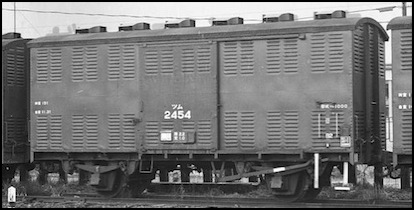
TuMu 1000 (c. 1981)
Photographer: Hanabi123
Types
TU (ツ), TUMU (ツム)
TU 4000, TUMU 1, TUMU 1000
The ventilated boxcar, used for transport of non-refrigerated fruits and vegetables, was obsolete by 1985. It has likely been replaced by ventilated containers
Baggage Car
For express parcels and passenger baggage use, apparently not past 1986 (when baggage and express car use was discontinued). Note that these names don’t follow the usual freight-car syntax as they are considered passenger cars rather than freight (in passenger cars, the first syllable denotes total weight, not loading weight, with SU meaning 37.5 - 42.5 tons and MA meaning 42.5 - 47.5 tons). NI is the typical suffix used for passenger baggage cars, while YU is used for mail cars.
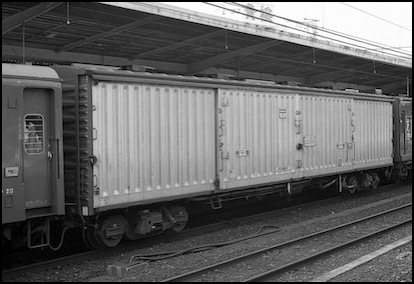
SuYu 44 (1984)
Photographer: spaceaero2
Types
SUNI (スニ), SUYU (スユ), MANI (マニ)
SUNI 40
SUNI 41 (apparently incorporated a conductor’s compartment)
SUYU 44
MANI 36 MANI 37, MANI 60, MANI 61, MANI 44
WAKI 8000, WASAFU 8000
The SUNI 40 was introduced in 1968 to enable loading of baggage on pallets. The entire side consisted of four sliding doors. The SUNI 41 followed in 1969 and added a separate conductor’s compartment, eliminating one of the doors. Use of baggage cars was eliminated in 1986, prior to the JNR breakup, and the cars were not transferred to JR. The WAKI 8000 and WASAFU 8000 were variants of the two SUNI models (the WASAFU had the conductor’s compartment), apparently used for express freight. The SUYU variant was a private car series owned by the Ministry of Posts and Telecommunications (the Japanese Post Office). All models were apparently rated for 95 kph use.
The MANI 36 & 37 and MANI 60 & 61 were older baggage cars (possibly both variants of the 60-series passenger cars). Some of these appear to have survived until the end of baggage car use in 1986.
The MANI 44 is a variant of the SUNI 41 (NOT of the MANI series described below, despite the name) designed for palletized express cargo use and including a conductor’s compartment. With the end of this business in 1986, JR Central acquired these cars, which were used in the Nagoya Car Train (see the description of WAMU for more on “Car Trains”) among other uses. All were eventually scrapped.
Money Car
The Money Cars were used by the Bank of Japan to transfer currency. These were armored express baggage cars, with separate compartments for baggage (money), guards and the conductor. Note that the name is both the same as that used for the MANI express car and a multi-lingual pun on the English word “money” (and the Japanese love multi-lingual puns, so it was probably intentional, as well as a good way to disguise the true purpose of the car).
MANI (マニ)
MANI 34, MANI 30
The original MANI 34 series was introduced in 1948. The MANI 30 replaced them in 1979. Prior to the JNR breakup they were coupled in passenger trains similarly to express baggage cars. After that, JR Freight owned them, and they operated mainly in freight trains. While in use, they were considered sensitive, and Japanese fan magazines and sites were not supposed to publish information about them, but their use was discontinued in 2003 (per this blog posting). Micro Ace (and others) have made models of these.
Flatcars
The standard flatcar is classified TIKI, but there are many specialized versions with different classifications. And some TIKIs were created from obsolete cars of other types.
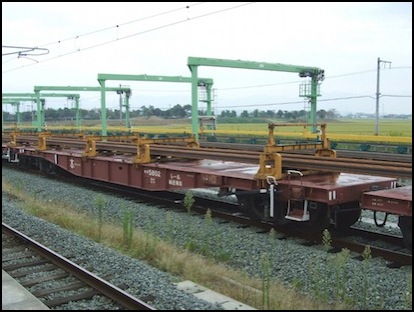
TiKi (aka ChiKi) Flatcar (2007)
Photographer: 投稿者 Muyo master
Types
TIKI (チキ) or TI (チ), flatcar (also CHIKI or CHI, which may be more common)
TI 1000
TIKI 100, TIKI 5000, TIKI 6000, TIKI 5500, TIKI 7000, TIKI 50000, TIKI 60000
The TIKI 5000 and TIKI 5500 are former container flat cars converted to carry welded rail. As of 2009 a number of them remain in service with various JR Group companies. The TIKI 6000 was apparently produced by remodeling existing 5500-series KOKI flat cars with TR63F trucks, and is also used in welded-rail transport. However at least one (TIKI 6141) was used for transporting heavy loads, and this use may have preceded the welded-rail application.
The TIKI 7000 flatcar was produced in 1975 to replace older cars, but production was halted the same year (after 150 were produced) due to lack of funding by JNR. A few apparently remain in use for welded rail transport and other maintenance of way duties. Subsequently the TIKI 6000 was produced (from 1976 to 1981), as described above, to provide replacements.
The TIKI 100 was produced in 1989, based on the 50000. This vehicle had rails and a winch, and carried 20’ U30S containers, but was essentially a flatcar (as it was loaded by winch, not by forklift) and classified as such. It was apparently used to transport automobiles by Isuzu Motors on a specific route.
The TI 1000 is a two-axle car with a weight limit of just ten tons. However, despite dating from 1957 some remain in use. This is used for transporting long loads, likely where a non-load-bearing spacer is required to move the load-bearing cars apart or provide a gap between them and either the locomotive or caboose. It is also apparently used for lightweight cargos.
Container Flat Cars
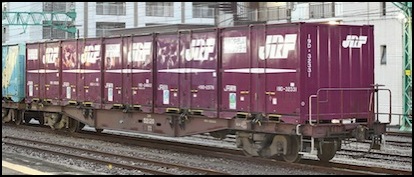
KoKi 50000 (2009)
Photographer: Tennen-Gas
Types
KOKI (コキ), container flat car; KOKIFU (コキフ), container flat with compartment
KOKI 5000, KOKI 5500, KOKI 10000, KOKIFU 10000, KOKI 50000, KOKIFU 50000
KOKI 100 series: 100, 101, 102, 103, 104, 105, 106, 107, 110
KOKI 200
Because a caboose could not be used on express trains, the KOKIFU incorporated the conductor’s room on the end. However, pictures show that the compartment end did not have to be at the tail of the train, and the cars could be operated with the KOKIFU on the end, but in reversed orientation. According to a footnote on the Japanese wikipedia, this was common in later years to prevent injury to conductors from rear-end collisions.
The KOKI 5000 and KOKI 5500 were early models of container flat car (built from 1959), initially limited to 3t containers (later 5t), they were unable to carry 20-foot containers. They were retired by 2008 from commercial operation, however a large number were converted to carry welded rail for maintenance trains, and renamed as TIKI flatcars. Most were limited to 85 kph, but some variants were converted for 95 kph use.
The KOKI 10000 was developed in 1966, as an evolution of the 5500, to counter the rise in trucked freight, and had a top speed of 100 kph. As this was beyond the speed of a YO, one car in the train (typically the last) would be a KOKIFU 10000 that had an attached compartment that served the purpose of the caboose. Use of the KOKI 10000 series was apparently abolished in 1996. A number of KOKI 10000 cars (188 per wikipedia) were converted to TIKI 5200 cars for welded rail use. Additionally some (14?) KOKIFU 10000 cars were converted to KOKIFU 50000 (series 59000), again per Japanese wikipedia.
The KOKI 50000 was introduced in 1971, with the ability to carry 20-foot containers (these are C20 domestic containers, but they’re measured in feet, not meters) for rail/truck use. Similarly to the 10000, this was based on the open-deck side-frame design used in the 5500. The standard top speed was 95 kph, but some variants for 100 kph (series 250000) and 110 kph (series 350000) use were created. When JR Freight adopted these, the standard red color was changed to green on the 250000 series cars, as they were no longer always used in dedicated express trains. Some 350000 series trains with “electromagnetic brakes” were created, and painted “Shonan Orange” to distinguish them from other cars. The general 50000-series trains are apparently still in use, but are being replaced by the KOKI 107. Some were also converted to TIKI 100 and TIKI 900 series flatcars.
After the creation of JR Freight a new generation of container flat cars was developed, the 100 series (KOKI 102, etc). Several prototypes (model 100) were produced and tested in 1987, and mass production began in 1988 with the 101 series. Among other things the new design had a 10cm lower deck than earlier models, to permit loading of ISO containers in addition to domestic containers. These supported loadings up to 40.5 tons per car (40.7 tons on the 106/107/110). Support for ISO 40-foot containers was apparently introduced on the 102 series c. 1993 or 1994, when new bearings (I think; translation is unclear) were introduced. The Japanese wikipedia page on the 100 series has a nice table giving dimensions and other specifics of the differing models, so I won’t repeat that here.
The KOKI 100 series has a top speed of 110 kph (operation may be limited to 100 kph depending on loading and the line on which it is used). Starting with the model 102 they could load up to five domestic 12-foot containers, three domestic or ISO 20-foot containers, two domestic 30-foot containers or one ISO 40-foot container. The 105 series is similar to the 104 but omits the ability to load ISO 40-foot containers, and may have been produced for use in a specific service (I saw a cryptic reference to a “Hamamatsu west by train between the (other) - Fukuoka” use in the Japanese container loading website). The 106 series was originally produced in blue, but a later production was painted gray to differentiate them, and blue ones are being repainted gray as they are brought up to the new design. The 107 is an update of the 106 design, also painted in gray, with changes to the layout of equipment (like brake cylinders). The 110 series was a specialty design for carrying 15-foot containers, and painted yellow (or “mustard”) to make this difference clear. As it can also carry standard domestic containers, these are found in general service as well.
The KOKI 200 series, introduced in 2000, was designed to carry a pair of ISO 20-foot containers exceeding the allowed weight limit of the 100 series, allowing transport of two containers up to 24 tons each (versus to the 20 ton/container limit of the 100 series). This allows, among other things, use of ISO tank containers for hauling sulfuric acid. A single container of up to 30.48 tons can also be loaded. Unlike most KOKI, there is no provision for loading 12-foot domestic containers. These are painted red with gray trucks.
Specialty Flat Cars
Flatcars built for specific purposes are typically given a different categorization than general-purpose flat cars, although this doesn’t seem to be universal.
SHIKI (シキ), specialized multi-axle heavy-load flat cars of several types
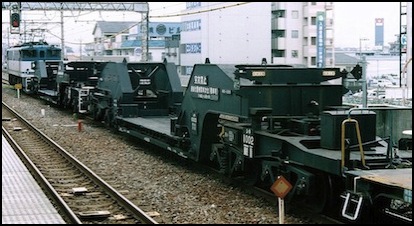
ShiKi 1000 (2004)
Photographer: まも(Mamo)
Types
SHIKI 100, SHIKI 160, SHIKI 550, SHIKI 600, SHIKI 610, SHIKI 670, SHIKI 700, SHIKI 800, SHIKI 850, SHIKI 1000
There are a number of heavy-duty specialty flatcars still in use in Japan. These fall into several classes, and some cars can be rigged to work as more than one class. Class A are “low floor” (a.k.a., “depressed center”) flat cars with the deck and ends a single unit. Class B are separate end units that clamp to a suspended load between them (known in the west as Schnabel cars, see graphic). Class C are “dropped” flatcars; apparently a variant of B that has a split beam between the ends with a hole in the middle, known in the west as “well” cars. And class D are “low floor division” cars, which appear to be similar to class B/C, but with a flat deck suspended between the ends, very close to the railhead, making them similar to class A in a sense, but for greater loads. Wikipedia has a graphic showing three classes, but the one identified as “A” appears more like the “D” described above.
The SHIKI 100 was a 1940 design (only one was built) which remained in service until 1994.
The SHIKI 160 is a class B design, built in 1955 for Fuji Electric and later owned by JNR and JR. It last transported a load in 1997, and was donated to the Mie Inabe City Freight Railway Museum in 2007.
The SHIKI 550 is a six-axle class A design that can operate at speeds up to 65 kph. Twelve cars were built between 1961 and 1966, and all passed to JR Freight in 1987. Some were scrapped c. 2006, but if I’m reading this correctly four are still in use.
The SHIKI 600 and 610 were similar designs with 24 axles. The 600 was a single car built in 1960 for Fuji Electric. The 610 was a series of five cars (610-614) built from 1962 for JNR. Both models could carry loads of up to 240 tons suspended between the end units at speeds of up to 45 kph when loaded. The 600 was scrapped in 2002. It would appear that the 611 survives, with the others being scrapped either in 1987 (612) or 2001-2005.
The SHIKI 670, built in 1971, could be rigged as either class B or C, and could carry 120 tons at speeds of up to 45 kph when loaded. It appears to have been scrapped in 2005 after passing through Mitsubishi’s ownership (or perhaps there were two, and the JRF one was scrapped; I’m not certain I’m reading this correctly).
The SHIKI 700 was a series of two privately-owned 28-axle class “B” flatcars designed for transporting large transformers, manufactured in 1961. They could operate at speeds up to 65 kph (I think that’s unloaded) and could carry loads up to 280 tons. They were no longer needed after 1982 (it’s unclear if they were scrapped, the wikipedia page just says “expelled”, which could mean they’re collecting rust on a factory siding somewhere).
The SHIKI 800/801/810 are 16-axle cars which can be rigged as either type C or D. In the C configuration they can carry loads of up to 140 (or 155 or 160, I’m not sure how to read it) tons. The 800 and 801 were built in 1973 and 1974, and the 810 in 1996.
The SHIKI 850, built in 1976, can be rigged as either a C (with a load of up to 115 tons) or as a low floor “D” flatcar (with a load of up to 85 tons). Nippon Express continues to own the 800 models and the 850.
The SHIKI 1000, built in 1975, is an 8-axle “D” flat car limited to 53 tons and a top speed of 65 kph when loaded, allowing it to better fit in with other traffic. It would appear that JR Freight is the current owner of the 1000, although it was owned by Nippon Express for a time (and I think it originally belonged to JNR, but the translated wikipedia page is hard to figure out).
Tomix made a model of the SHIKI 1000 in configuration D (low deck) and Micro Ace makes models of the 600 and 810 in configuration B (Schnabel car), and the 800 in configuration C (well car).
Auto Transporter Flatcar
KU (ク), KUMU (クム), flat car for transporting trucks or cars. See also SIMU.
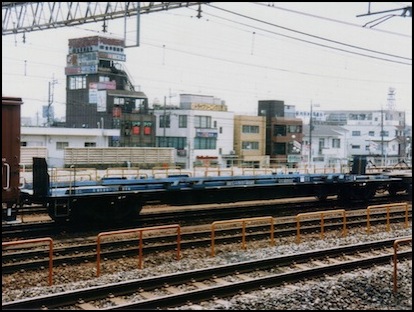
KuMu 80000 (year unknown)
Photographer: Yamato-i
Types
KU 5000, KUMU 80000
The KU 5000 was produced from 1966 to 1970, with 932 manufactured. It was based on the SIMU 10000. This used a drive-on, drive-off loading method. Cars were protected from dirt and flying ballast by tied-down sheets covering them. Although originally designed for 85 kph use, unspecified problems discovered in tests limited them to 65 kph. Declining use after 1975 saw this car rapidly discontinued and the last was scrapped in 1983.
The KUMU 80000 was produced from 1986 to 1991, with a top speed of 100 kph, and remained in service until 2000. The last car was scrapped in 2003.
Gondola Cars
TORA (トラ), older wood-side 2-axle gondola car, TOKI (トキ), gondola car
Gondola cars are open topped, with relatively low sides. At least on some models the sides can be removed, allowing them to be used as flatcars with bulkhead ends. The TOKI 15000 was an outgrowth of earlier car designs produced from 1948 to 1953 with a 35-ton capacity (30 tons when used for coal), and appear to have had numbers up through 19245, although I’m not clear on the translation. Derivatives and variations were produced with 21xxx series numbers. All of these apparently disappeared by the 1980’s, except for some 21500 series coil-steel cars which may have been in use through 2008 (again, unclear translation). The TOKI 25000 was a 36-ton capacity evolution produced from 1968 to 1976 (to distinguish these from the TOKI 15000, the car is marked “オ トキ”, or O-TOKI). Subsequent and derivative versions of these bearing numbers into the 29xxx range were produced through 1981 (about 4500 cars were produced in total). Later models used roller-bearing trucks (rather than two fixed axles with friction bearings as was typical of smaller and older freight cars), but a top speed is not documented. Again most appear to have been scrapped by the 1980’s although some remain in use for maintenance of way purposes (image is of one used in rail-supply trains from JR East’s Etchujima Freight station), and possibly other uses. However, twelve variant 25000 40-ton models (numbered 25000-1 to 25000-12) were produced in 1999 to carry Zinc concentrate for a private shipper (Toho Zinc). The latter is limited to 75 kph operation, although the web page suggests this could be raised with some simple modifications to 95 kph if required.
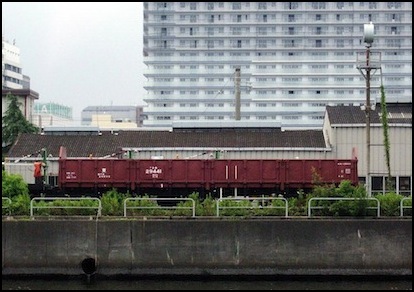
ToKi 25000 (2009)
Photographer: Nzrst1jx
Types
TORA 45000, TORA 70000
TOKI 15000, TOKI 25000 (see also JR Freight 25000 entry)
Hopper Cars
HOMU (ホム), HOKI (ホキ), HOSA (ホサ), SERA (セラ), and SEKI (セキ)
A hopper car has higher sides than a gondola, and is typically emptied by being dumped through an opening on the bottom (although some have side dumping instead, and some may be designed to be turned upside-down in a rotary dumper). The HOKI, and the smaller HOSA, are the general class of hopper car; this includes both open-topped and closed hoppers. These appear to be most commonly used to transport crushed stone (typically limestone) for construction use although the designation is also used for coal cars. There are also specialized cars, such as the SERA, and SEKI coal cars.
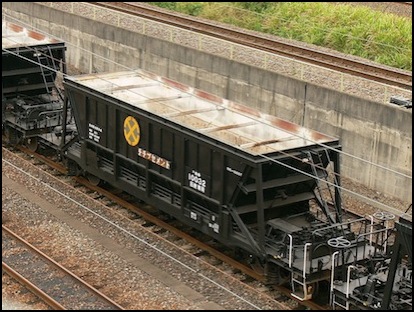
HoKi 10000 Coal Hopper (2009)
Photographer: まも(Mamo)
Types
HOMU 1
HOKI 800, HOKI 2100, HOKI 2800, HOKI 7600, HOKI 9500, HOKI 10000
SERA 1
SEKI 3000, SEKI 6000, SEKI 8000
The HOKI 9500 was introduced in 1970 to carry crushed stone during the construction of Narita airport. Afterwards, the cars transitioned to Japan Oil Company ownership and were used the transport limestone and remained in use (through other owners, possibly with Taihaiyo Cement as the last) at least through 2009.
I’ve seen one reference to (and a couple of photos of) a HOMU 1, belonging to the Hokuriku Railway and dating from 1961, which appeared to be still in service.
The SEMU/SERA/SEKI designation are used for coal cars. Per Wikipedia (Japanese “Coal Car” entry) there are two main classes of cars in Japan: those used in Kyushu were based on German practice with a bottom-dump design, and those used in Hokkaido on U.S. practice using a side-dump design. Coal transport in Kyushu largely ceased in 1986 and most cars were scrapped. At least some SEKI 6000 and SEKI 8000 were converted to carry limestone. Some coal traffic remains as of 2011, but using HOKI 10000 cars (see below).
The SERA 1 design was a 15 ton two-axle model used in Kyushu between 1957 and the end of coal transport in 1986.
The SEKI 3000 (linked photo shows a 3000, left, and an 8000, right) and SEKI 6000 are similar designs using a pair of two-axle trucks, which was used in both Kyushu and Hokkaido. All have a capacity of 30 tons. The 3000 was rated for 55 kph loaded, 65 kph empty. The 6000 was a variation introduced in 1968 that could operate at 65 kph when loaded. A few SEKI 3000 cars were modified into 25-ton limestone cars capable of 75 kph operation and designated HOKI 2800, these were inherited by JR Freight but phased out by 1995. Some cars were modified in 1963 - 1969 into 35-ton cars to carry limestone and iron ore, and designated HOKI 2100, but the last of these were scrapped in 1985. The SEKI 3000 was scrapped by 1993, and the 6000 by 1998. Apparently these SEKI cars were also used to transport limestone, iron ore, sulfide ore and sugar beets.
The SEKI 8000 was a two-truck, 30-ton design manufactured in 1981 to replace worn-out SEKI 3000 and 6000 series cars. The cars were redesigned to reduce derailments due to the short wheelbase and high center of gravity of the older cars, and were rated for 75 kph operation. These were scrapped by 1998 after Hokkaido coal traffic moved to trucks (starting in 1993).
The HOKI 10000 is a two-truck, 35-ton, bottom-dump design produced in two series in 1980, numbers 10000 - 10249 were built for coal service for the Chichibu Cement Co. between Kawasaki and Mikajiri station on the Chichibu Railway in Kumagaya and 10250 - 10271 were built for Denki Kagaku Kogyo (a large cement and chemical conglomerate). The Chichibu cars remain in service (now owned by Pacific Ocean Cement, a subsidiary of Taiheiyo Cement) and serving the same function (14 are used for limestone transport). The others were scrapped in 1996. Note: although apparently owned by Pacific Ocean Cement, they appear to be marked for and used by its parent company, Taiheiyo Cement, which was formed from the merger of Chichibu and Onoda Cement in 1998. Per one blog, the Kawasaki-Kumagaya operation is the last remaining mainline coal service in Japan. A combination of DE10 and EF65 locomotives are reportedly used, although DE11 2001 appears in several photos and videos.
Shortly afterwards (c. 1982) a similar design designated HOKI 7600 was constructed for Japan Oil Transportation, which carried coal on return trips and cement outbound (if I’m reading the HOKI 10000 page that describes them correctly, a removable or replaceable liner was used, so the two products wouldn’t contaminate each other). These were inherited by JR Freight, and scrapped in 1999.
Tank Cars
TAKI (タキ), tank car
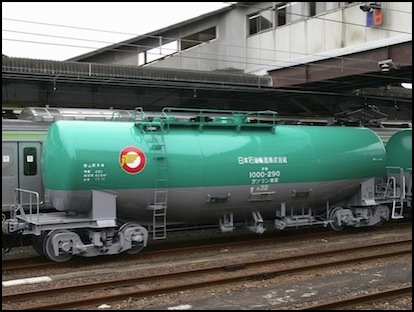
TaKi 1000 at Hachioji Station, Tokyo (2006)
Photographer: Chabata k
Types
TAKI 3000, TAKI 9900, TAKI 1000, TAKI 35000, TAKI 43000, TAKI 46000, TAKI 50000, TAKI 64000
The TAKI 3000 is a post-war framed (or “side beam”) design, used to carry petroleum and similar products. It’s notable mainly because three of them carrying petroleum were involved in the 1967 collision, and subsequent fire, with a limestone train adjacent to Shinjuku station, which led to the eventual banning of freight trains from many of the city-center lines and construction of various bypass routes to shift freight away from heavy-use lines. JR Freight inherited a number of these, but they were replaced by other models and the last was scrapped in 2002.
Modern tank cars are a frameless design, apparently originating with the TAKI 50000 (gasoline) and TAKI 55000 (other petroleum) 50 ton tank cars in 1960, and widely produced in a variety of similar models, most of 35t capacity (see below). The majority were produced to carry gasoline and other petroleum products (typically two similar but different models), but some specialized models were also made. The TAKI 50000 was retired in 1993. The first 35t model, the TAKI 9900 was retired in either 2000 or 2008 (the translation is a bit muddled). These early models were a simple cylinder, with both top and bottom level.
The TAKI 35000 (gasoline) and TAKI 45000 (other petroleum) is a numerous class, although now being displaced by the TAKI 1000 which can operate at higher speeds. In these, the tank top bows up towards the center, and the underside bows down. A total of 1108 35000‘s and 589 45000‘s were produced between 1966 and 1972, and 357 of the 35000 remain in service (as of 2010, per wikipedia). They are rated for 75 kph service.
The TAKI 46000 (sulphuric acid) is a variant of the 35000, painted black. Between 1985 and 1990 a total of 71 were produced. The TAKI 7250 (alcohol) is another variant; 115 were produced from 1967 to 1970. Although described in wikipedia as a variant of the 35000, the one photo I’ve seen of a 46000 shows a design similar to the 9900, only with an end-to-end frame (similar to the much older TAKI 3000) and its possible that the same series was used for two kinds of tanks.
The TAKI 43000 (gasoline) and TAKI 44000 (petroleum) tank cars, introduced in 1967, have been produced in considerable volume, and owned by both private companies (Nippon Oil and Eneos) and JNR/JRF. In these, the tank has a level top but an underside that curves down between the trucks. These are still widely used, but are limited to a top speed of 75 kph, which is problematic when sharing lines with passenger trains. Scrapping of at least some of these has begun as of 2010.
The TAKI 1000, a tank car for petroleum products, was introduced in 1993 as a successor to the TAKI 43000 and its variants. They are visually quite similar. Among other improvements, these can operate at speeds up to 95 kph. In these, the tank has a level top but an underside that curves down between the trucks.
Caboose
(often translated as “brake van”, the British English term for caboose)
WAFU (ワフ), YO (ヨ)
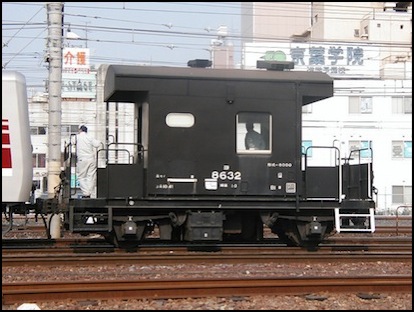
Yo 8000 at Soga Station, Chiba (2005)
Photographer: Yamato-i
Types
WAFU 21000, WAFU 29500, YO 6000, YO 8000, YO 9000
One common caboose was designated WAFU (ワフ), meaning a “WA” (boxcar) with loading weight less than 14 tons equipped with a compartment. This reflected the caboose’s dual role as both the conductor’s office and an express-cargo vehicle (also used as a postal car and a baggage car on passenger trains), typically with space for only a couple of tons of cargo.
In the 1970s, these and other earlier designs were largely replaced with the YO 6000 and YO 8000, but general use of cabooses was discontinued at the breakup of JNR in 1987, probably in association with the staff reductions that took place at that time (or perhaps with the closure of the general freight classification yards, which took place in 1985). Earlier models were limited to 65 kph, but the YO 8000 is rated for 85 kph. A few remain in use for specialty trains, such as crew accompanying an oversize load or transporting new locomotives or passenger trains from factory to the owner’s railroad. Attempts were made in the late 1960s to develop a 100 kph version, the YO 9000, but these were a failure and the model was never produced (the prototype was not in use past the JNR breakup, but was apparently preserved).
Combination Caboose/Freight Cars
The suffix FU (フ) added to a name indicates a car with a compartment added for a brakeman or conductor. Specialized car/compartment vehicles were built for some JNR-era high-speed (100 kph, and some 110 kph) express freights, and used from 1966 until abolition of the use of conductors for normal freight trains in 1985 (per Japanese wikipedia). It is unlikely any of these specialized cars remain in use.
Note: additional infomation on the FU types is listed with the entry for the associated car type (e.g., see the WAMU entry for data on the WAMUFU).
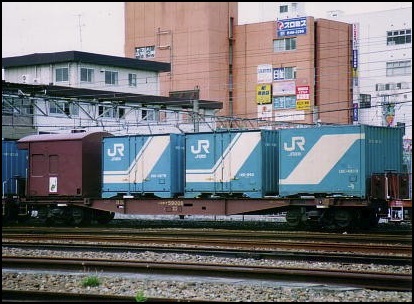
KoKiFu 50000 at Soga Station, Chiba (date unknown, post-1987)
Photographer: Yamato-i
Types
KOKIFU (コキフ) is a flat car with a small caboose-like structure on one end.
REMUFU (レムフ) is a refrigerated boxcar.
WAMUFU (ワムフ) and WAKIFU (ワキフ) are ordinary boxcars with a compartment.
WASAFU (ワサフ) is an express freight car with a compartment (see the description of SUNI).
References
As usual, much of the information here has been summarized from Wikipedia pages, including translations of Japanese Wikipedia pages, and is thus subject to error (especially the machine-translated stuff).
A list of Symbols of the Japanese Trains from Plaza Japan’s store website (includes a partial list of the freight care prefixes, as well as information on the meaning of the suffixes).
Japanese Railway Society Locomotives and Rolling Stock guide by Edward Talbot (includes a partial list of the freight care prefixes, as well as information on the meaning of the suffixes).
Wikimedia photos of JR Freight Cars
Wikimedia photos of JNR Freight Cars
Wikipedia list of JR Freight Cars (incomplete; it doesn’t even list all the ones for which there are wikipedia pages)
Transition of Railway Freight Transport in a Competitive Market (PDF), Kiyoshi Okada, JRTR vol. 5, July 1995.




